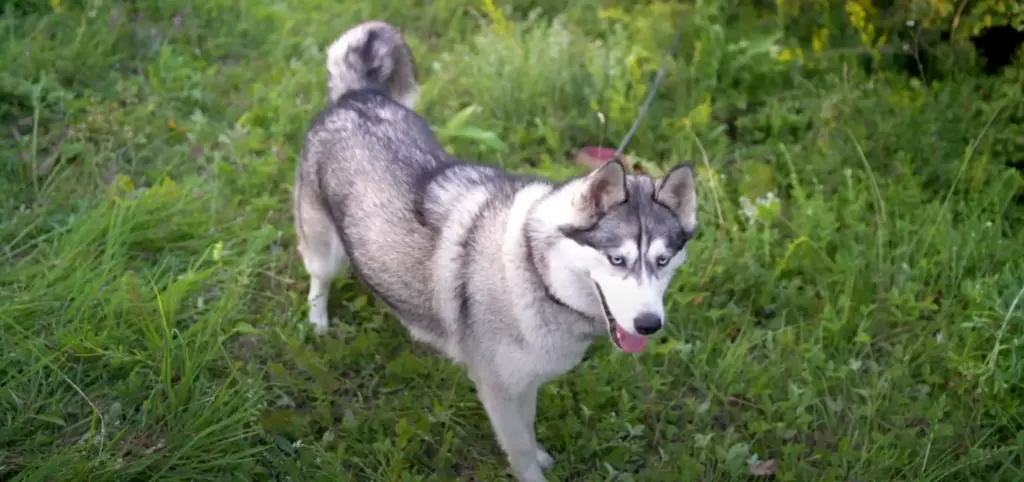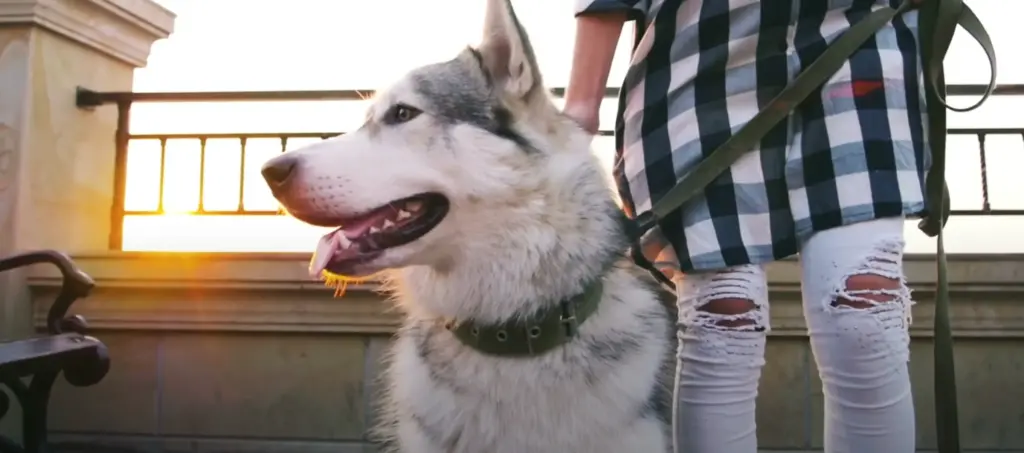As they say, variety is the spice of life, and the Huskita—a crossbreed between the Akita and Siberian Husky—embodies this maxim in the canine world.
You’re looking at a dog that boasts a blend of traits that may be the perfect addition to your family or a challenge, depending on your lifestyle.
The Huskita inherits the Akita’s loyalty and the Siberian Husky’s playful nature, but don’t let this fool you into thinking they’re a straightforward breed to handle.
Their independent streak demands a firm, consistent hand in training. They’re known to be affectionate with their owners, yet their size and energy levels require ample space and exercise.
If you’re pondering whether this beautiful hybrid fits into your home, consider what it takes to keep up with a dog that’s both a devoted companion and a spirited powerhouse.
Join us as we explore the complexities that define Huskita’s temperament and the care they need to thrive. You might discover whether you’re ready to meet the demands of this intriguing mix.
- Noise Level
- Energy
- Sociability
- Trainability
- Care
- Health
Overall
Summary
The Huskita is rated as moderately noisy with a 3.5-star rating, highly energetic with 4.5 stars, moderately sociable with 4 stars, moderately trainable with 3.5 stars, moderately high maintenance with 3.5 stars, and generally healthy with 4 stars.
Huskita: Traits, Temperament, and Care Guide
The Huskita, a robust blend of Siberian Husky and Akita, exhibits traits that demand an owner’s commitment to rigorous exercise, thorough socialization, and diligent training.
This mixed breed thrives when integrated into an active lifestyle, necessitating 45 to 90 minutes of daily exercise to mitigate their high energy levels.
Notably, Huskitas can be good with children, yet their protective nature requires careful management to ensure they don’t misinterpret benign interactions as threats.
The high prey drive of a Huskita puppy calls for early socialization to curb potential aggression.
Prospective owners must be prepared for a loyal and protective companion that will shed quite a bit, reflecting the need for moderate to high grooming.
Exploring the Characteristics of the Huskita
As we consider the Huskita’s need for exercise and socialization, let’s examine the distinctive characteristics that define this energetic mix of Akita and Siberian Husky. When adequately trained, the Akita Husky mix, or Huskita, is renowned for traits that make them a good family companion. Their loyal and protective temperament requires early socialization to ensure they develop into well-adjusted pets. Huskitas are highly active, necessitating a commitment to regular physical activity to manage their energy levels and prevent weight gain. The robust double coat of a Huskita offers a variety of colors and requires regular grooming.
| Trait | Description | Importance |
|---|---|---|
| Energy Level | Highly active, needs regular exercise | Prevents obesity |
| Temperament | Loyal and protective, can be independent | Requires training |
| Coat Type | Dense double coat, various colors | Needs grooming |
Huskita: A Comprehensive Profile and Guide
As you consider the Huskita for your next canine companion, it’s essential to understand its comprehensive profile. This breed blends the Akita’s boldness and the Husky’s exuberance, requiring a nuanced approach to training and socialization.
Your awareness of the Huskita’s exercise needs and potential for weight gain is critical in maintaining its health and temperament.
Everything You Need to Know
Delving into the Huskita’s profile, you’ll discover a dynamic blend of the Akita and Siberian Husky’s traits, offering insights into their robust character and care requirements. The Akita Husky mix, known as Huskitas, are large, energetic dogs with complex temperament. Their personality traits are a tapestry woven from both parent breeds:
- Loyalty and protectiveness from the Akita
- Playfulness and vigor from the Siberian Husky
Huskita’s need for family interaction and exercise is paramount:
- Regular, rigorous exercise to manage their energy levels
- Without it, undesirable behavior may surface
- A strong sense of family belonging, making them potential therapy dogs
- They adapt well when involved in family activities
Informed care fosters a well-balanced Huskita, integrating them seamlessly into their human pack.
Discovering the Temperament
The Huskita’s temperament combines high energy and alertness with marked independence, often balancing loyalty and potential for aggression with an innate intelligence that facilitates training.
As a designer breed, a mix of Akita and Siberian Husky, the Husky Akita is highly energetic and requires significant exercise—45 to 90 minutes daily—to thrive as a family member. Their independence means they don’t demand constant interaction but will bond deeply with their owners.
They can be wary of strangers, a trait that necessitates early socialization to mitigate any aggression towards unfamiliar people. Positive reinforcement is key in their training regime.
With the right guidance, Huskitas can make great therapy dogs, their loyalty and protective nature offering a sense of belonging and security to those they serve.

Huskita: Is It a Good Fit for Families?
Considering the Akita Husky mix, or Huskita, you must evaluate whether this breed aligns with your family’s lifestyle and experience with dogs.
Their protective nature and high energy levels necessitate a commitment to training and ample exercise, particularly for households with older children.
Families with small children or first-time dog owners should weigh the challenges of the Huskita’s territorial instincts and independent demeanor.
Assessing Huskita’s Compatibility with Families and Kids
Assessing a Huskita’s compatibility with family life requires careful consideration of its temperament, particularly its protective instincts and potential for snapping if mistreated by children. These Akita Husky Mix dogs are known to be loyal to their family, which can be a double-edged sword:
- Protective nature
- May be vigilant guardians for kids and other pets
- Possibility of overprotectiveness leading to issues with small children
- Behavioral traits
- Their large size and high activity level require ample space and exercise
- A tendency to drool may not suit those with sensitivities or allergies
Families must evaluate if they can accommodate a Huskita’s needs and manage its temperament. The breed’s vigor and potential for robust play are factors to weigh, especially with young children or elderly members in the home.
Huskita Adjustability Quirks
Navigating Huskitas’ distinctive behavioral landscape requires understanding their potential for territorial and possessive actions, particularly without early and consistent socialization.
As an Akita Husky mix, your Huskita can have an average energy level that reaches the higher end, necessitating regular exercise between 45 to 90 minutes daily. This routine curbs their tendency to wander and supports a balanced Huskitas diet by expending energy appropriately.
Without consistent daily engagement, these dogs may turn aggressive, particularly towards strangers, signaling a misalignment in their environment. Leaving them alone for long periods can exacerbate this issue, as they require regular mental stimulation to maintain an even temperament.
Hence, your commitment to their training and socialization is crucial to mitigate dominance testing and encourage adaptability.
Huskita Obedience Tips
You must promptly initiate your Huskita’s obedience training to assert your leader role and set clear boundaries.
Positive reinforcement methods, such as treats and praise, effectively motivates and affirms their proper conduct.
Effective Training Strategies
To effectively train a Huskita, prioritize positive reinforcement methods—such as offering treats, praise, and playtime—to encourage and solidify desired behaviors. With a Siberian Husky parent and Akita Mix lineage, your Huskita inherits a complex blend of traits from dog breeds known for high energy and independent spirits. Not all are easy to train, so implementing effective training strategies early is crucial.
| Strategy | Desired Outcome |
|---|---|
| Consistency | Reliable obedience and structure |
| Exercise | Mitigate behavioral issues |
| Socialization | Foster well-rounded interactions |
| Obedience Classes | Enhance training and social skills |
| Leadership | Establish respect and boundaries |
Join obedience classes to provide structure. Remember, your Huskita’s exercise needs are significant; daily physical and mental activities are essential for their well-being, reducing the chance of behavioral issues and enhancing socialization.
Exercise and Grooming Needs
Understanding the exercise and grooming needs of a Huskita is crucial, as their high energy levels demand substantial physical activity and their dense coats require regular maintenance.
The Huskita, a blend of Siberian Husky and Akita, inherits a need for vigorous exercise—a daily regimen of 45 to 90 minutes is essential to meet their amount of exercise requirement. Neglecting this can lead to behavioral issues due to pent-up energy.
Use a brush several times weekly to manage their rough and dense coats, reducing shedding and maintaining luster.
Without enough exercise and grooming, a Huskita won’t thrive. They need a lot of space, preferably with a fenced area, to explore and play.
Their exercise needs intertwine with their grooming needs, ensuring their physical and aesthetic well-being.

Health Considerations
You must be mindful of the health issues that Huskitas can inherit, such as hip dysplasia and hypothyroidism, which can impact their lifespan.
Regular veterinary check-ups are essential to detect and manage these conditions early on.
A balanced diet and consistent exercise regimen are key to mitigating risks like obesity and maintaining health.
Common Health Issues and Lifespan
Owners of a Huskita should anticipate a lifespan of 10 to 13 years, but must be vigilant for common health issues such as hip dysplasia and bloat that can affect this breed’s quality of life. As a large breed with a heritage from Siberian Husky and Akita, Huskitas are susceptible to health issues, particularly those related to bones and joints. Regular veterinary checkups are crucial to detect and manage conditions like hypothyroidism, obesity, eye problems, and skin diseases early.
It’s important to note that Huskitas’ erect ears can predispose them to certain infections and require careful monitoring. Ensure you’re equipped to provide the necessary care, ensuring your Huskita thrives throughout its average lifespan.
Is Huskita the Right Dog for You?
Determining whether a Huskita aligns with your lifestyle and environment is essential, as their substantial exercise needs and assertive personality demand a committed and experienced dog handler. This mix of Akita and Siberian Husky traits results in a large dog with a best temperament in homes with ample space, preferably in cooler climates.
Daily physical activity is non-negotiable; they require 45 to 90 minutes to maintain health and happiness. Affectionate yet independent, Huskitas can be territorial and aren’t ideal for being left alone for extended periods.
Your readiness to invest in consistent training, socialization, and grooming will ensure a harmonious relationship. If you’re up for the challenge, a Huskita may be the right dog for you.
Conclusion
In conclusion, the Huskita’s robust frame suggests a formidable powerhouse. However, its propensity for sofa squats can lead to an ironic twist in waistline expansion.
Your vigilant exercise regimen will be critical to circumvent this paradoxical inclination towards lethargy.
As a guardian of this spirited blend, you’ll navigate the complexities of its dual heritage. Ensuring that the Huskita’s loyalty doesn’t morph into overprotectiveness.
An analytical approach to its care will affirm whether this dynamic canine is your ideal companion.
